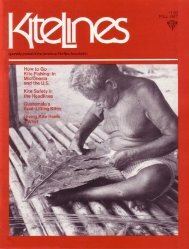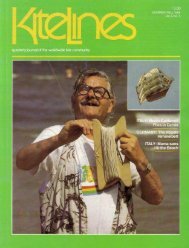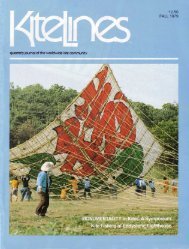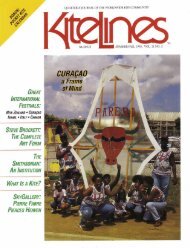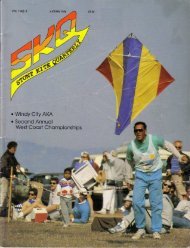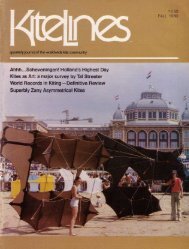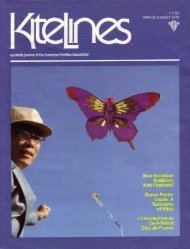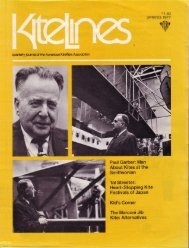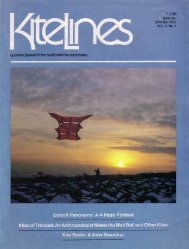Kite Lines - Vol.3 No. 1 - KiteLife
Kite Lines - Vol.3 No. 1 - KiteLife
Kite Lines - Vol.3 No. 1 - KiteLife
- No tags were found...
Create successful ePaper yourself
Turn your PDF publications into a flip-book with our unique Google optimized e-Paper software.
: the flatFirst in a SeriesThe GreatContemporary<strong>Kite</strong>s and theirinventorsBy Tal StreeterUntil a scant 31 years ago, there leavebeen only three generic, significantlydistinctive mainstream kiteskite, the hewed kit , , and the cellular o,•'box kite . Lawrence Hargrave's box wasthe first uniquely western kite, a kitewithout precedent in all of history,One which had the added distinctionof p laying a paramount rol e in thedevelopment of the first air lane . Itwas, of course, the airplane which Pitthalt to kite development . As a consequence, the three° haste kites seemeddestined to remain forever the mostperfect relationship between the windand ,r tethered flying object thathumankind would design .But there were to be more kites . Aspilot and fable-spinner Antoine deSaint-Exupery explained in Wind, Sandand Stars, "In anything at all, perfectionis finally attained not when thereis no longer anything to 'I'll" hilt whenthere is no longer anything to takeaway . . . '' Remarkably it appeared thatstill more could be taker away fromthe spare kiteflying machine, to refinestill further- the very essence of anOpin-created byobject in tethered flight. First, in 1948,-ante Francis ;11 . Rogallo's Flexikiteand, in 1950 . William M. Allison's sled,then, in 1967, Domina Jalbert's Parafoil.A ll were American designs . Mostrecently a contribution from Englandhas carried equiva lent rank in theion : the of Flexifoil,manyAndrew Jones and Ray Merry .Each of the four new kites hasMarkedly changed the character ofcontemporary kite forms and flying .Each has a loyal following as well asoutspoken critics, (Kiting is definitelya partisan af fair .) .4 re there now sevengeneric, significantly distinctive, mainstreamkites?*fifteen hundred years ago, Ecclesiasteslamented the futility of life, themonotony of all things, the windblowing in one direction, then theother, tin activities of men: " . .thereis no new thing under the sun. Is thereanything whereof it may b e sato, sec .this is new?" In kites, perhaps yes . Ibegan writing these articles with theintent of widening 111y own knowledgeof these kites, which I greatly enjoyed,and the lives of their inventors . Form y first essay, I choose the Englishman .ANDREW JONES, RAY MERRY AND THE FLEXIFOILA familiar sight in Europe's skies, GreatBritain's speeding Flexifoil is still littleknown in the United States . Whereasspeed has not generally been a considerationin typical kiteflying, the Flexifoildares to break speed records . It furtherchallenges the normal sedentary nature ofpleasure kiteflying by requiring strengthand endurance of its fliers .Advertising literature describes the"Flexifoil Skysail" much as I would, notingthat it "has been called a `flyingmattress' by those who have seen it forthe first time wheeling through the sky . Itlooks quite unlike any other kite . Six feetacross, the Flexifoil pulls like a horse .Land yachters and skateboarders use themto provide traction, attaining speeds inexcess of 20 miles per hour . A train ofFlexifoils has pulled a two-ton van uphillacross grass . The production rip-stop nylonFlexifoil is controlled by twin 200-footlines which run from the hand-held controlbar to the kite . By turning the bar,the flier can make the kite loop, dive andhedgehop just inches above the ground .The name `Flexifoil' derives from the flexingof the single fiberglass spar in theleading edge . This flexible spar enablesthe airfoil form to change its shape inflight and adjust to winds as light as 8miles per hour and as strong as 50 milesper hour . This same adaptability coupledwith the firmness of the spar allows theFlexifoil to accelerate to speeds in excessof 100 miles per hour . The sport of Flexifoilingis rapidly becoming a serious adultpursuit, including formation flying andstunt routines . A train of Flexifoils providesan unparalleled visual extravaganzasweeping across the skyline, lines screaming.Numerous applications for the worldpatented Flexifoil principle are being explored,including sailing, free flight andwind generators . Warning : Do not underestimatethe power of the Flexifoil . Evenone, in a strong wind, produces considerablelift, which makes it unsuitable forchildren under 12 years of age ."Aeronautical staff writer for PopularScience magazine Ben Kocivar verifiedthe Flexifoil warning for himself, flyingthe kite for the first time in London'sHyde Park and writing in PS, "The pullwas terrific . I had to lean far back as Iheld the control bar, maneuvering a trainof three Flexifoils," concluding that itwas "the most sophisticated controllablekite design I've seen ."David Pelham, author of The PenguinBook of <strong>Kite</strong>s, offered the opinion thatthe Flexifoil "is undoubtedly at the zenithof dual-control kite design ." (It was developedtoo late for inclusion in his book .)Reviewing the kite for <strong>Kite</strong> <strong>Lines</strong>(Spring-Summer 1978), Curtis Marshall said,"The Flexifoil, in a word, is different. Iwould not compare [it] only to stuntersbut to the whole genera of kites, in whichcompany it more than holds its own ."I've known the Flexifoil inventors RayMerry and Andrew W . (Wilf) Jones severalyears now . We have corresponded andconversed in a variety of situations invarious parts of the world . Wilf stayed atmy home for a too-short month in thesummer of 1978 . We traveled togetherdown south to meet Dom Jalbert inFlorida and Francis Rogallo in <strong>No</strong>rth




